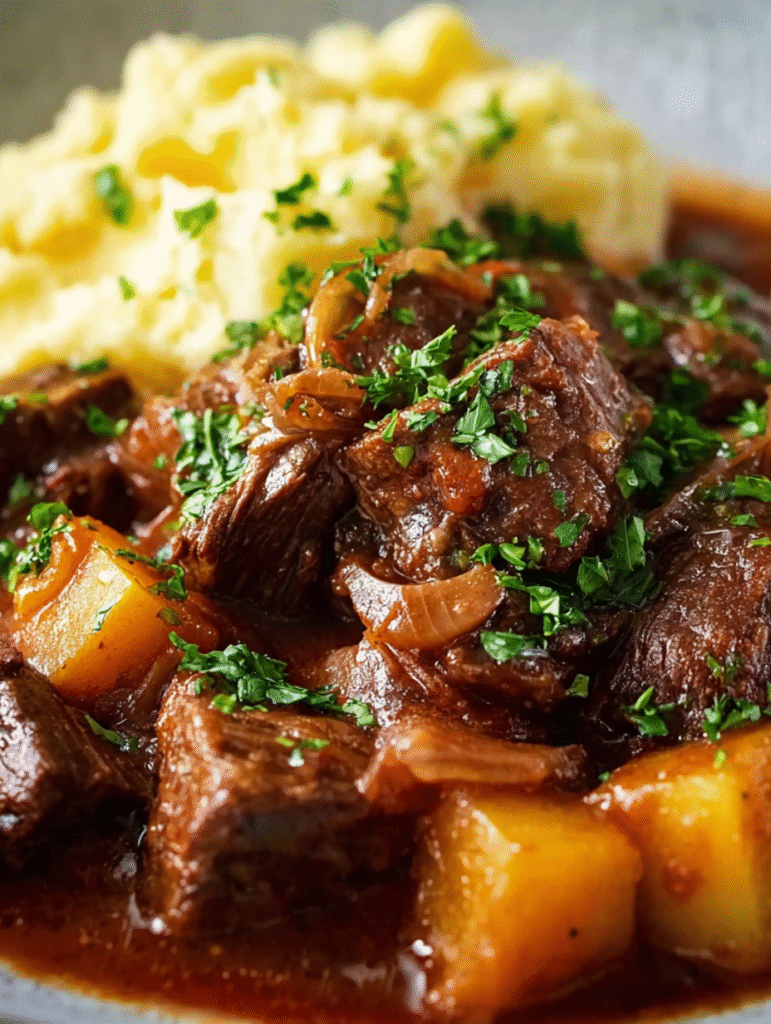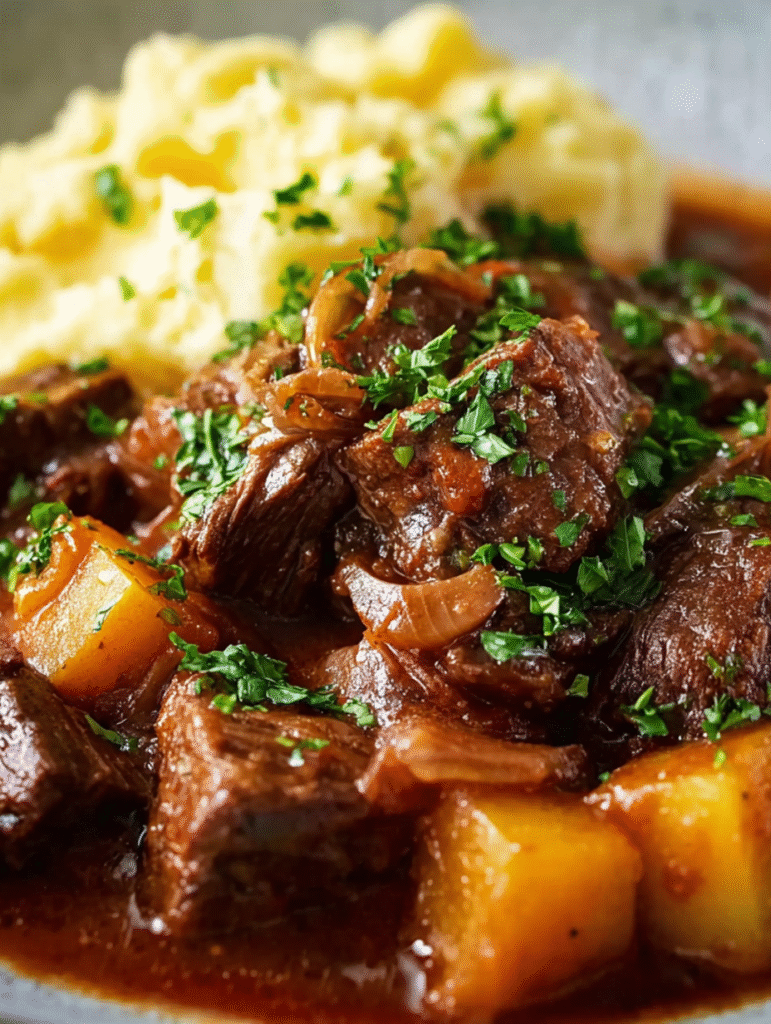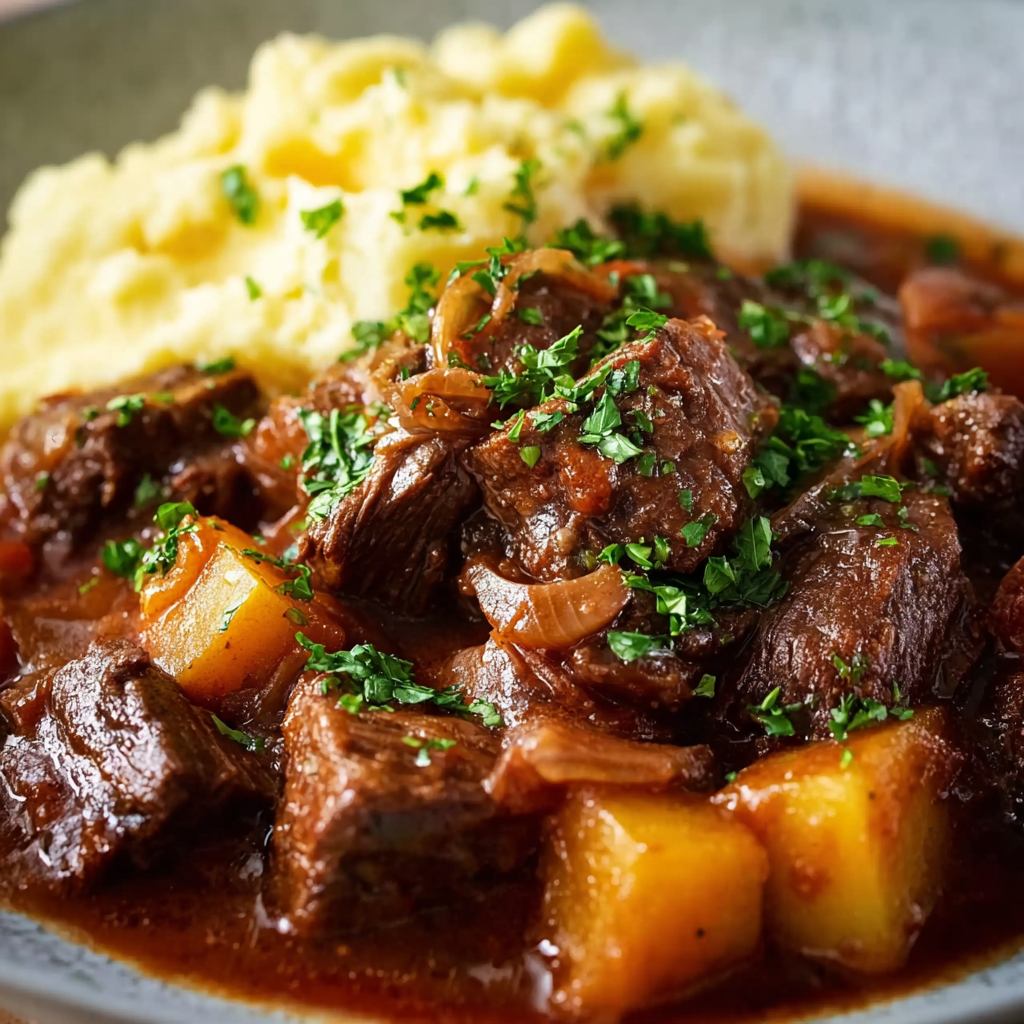Growing up in my grandmother’s kitchen, I was mesmerized by the way she transformed simple ingredients into the most incredible beef goulash that filled our home with the most amazing aromas. Her secret wasn’t complicated techniques or exotic spices – it was patience, quality ingredients, and the kind of slow, gentle cooking that creates magic in a pot. After years of perfecting her recipe, I can confidently say this authentic German goulash delivers the same soul-warming comfort that made Sunday dinners at Oma’s house so special.
This isn’t just another stew recipe – it’s a masterclass in how proper technique and time can transform tough cuts of beef into fork-tender perfection swimming in a rich, aromatic sauce that begs to be sopped up with crusty bread. Each spoonful delivers layers of flavor that develop during the slow braising process, proving that some of the best things in life really are worth waiting for.
Why This Authentic Goulash Will Become Your Go-To Comfort Recipe
Traditional German Excellence Made Simple This recipe strips away unnecessary complications while preserving all the authentic flavors that make German goulash legendary. Furthermore, the straightforward technique means even beginners can achieve restaurant-quality results at home.
Budget-Friendly Luxury That Feeds a Crowd Transform inexpensive cuts of beef into a rich, satisfying meal that easily serves six people. Additionally, this dish actually improves with time, making it perfect for meal planning and entertaining without breaking the budget.
Naturally Gluten-Free Comfort Food Unlike many traditional stews that rely on flour for thickening, this goulash achieves its perfect consistency through proper reduction and the natural gelatin from slow-cooked beef, making it naturally gluten-free.
Make-Ahead Friendly for Stress-Free Entertaining The flavors actually improve overnight, making this the perfect dish to prepare in advance for dinner parties or busy weeknight meals when you want something special without last-minute stress.
Essential Ingredients for Authentic Results
Premium Beef Selection
- 1 kg beef goulash meat (chuck roast, shoulder, or top round) – cut into 3×3 cm cubes for even cooking
- 2 tbsp clarified butter – high heat cooking fat that won’t burn
Aromatic Vegetable Base
- 500g shallots – peeled and left whole or halved depending on size
- 1 garlic clove, finely chopped – aromatic foundation
Flavor Building Liquids
- 400ml beef stock – rich, savory base
- 200ml dry red wine – adds depth and complexity (or substitute with 100% red grape juice)
Signature Seasonings
- 2 tbsp tomato paste – concentrates umami and color
- 2 tsp lemon zest – from organic lemon for brightness
- 2 tsp sweet paprika powder – essential German flavor
- Pinch of cayenne pepper – gentle heat balance
- Salt to taste – flavor enhancement
Step-by-Step Preparation Instructions
Preparing Components for Success
Step 1: Remove beef from refrigerator 30 minutes before cooking to bring to room temperature, ensuring even cooking throughout. Meanwhile, peel shallots and leave whole if small, or halve if larger for uniform cooking.
Step 2: Finely chop garlic and zest the organic lemon using a fine grater, being careful to avoid the bitter white pith underneath the fragrant yellow skin.
Creating the Foundation of Flavor
Step 3: Heat clarified butter in a large, heavy-bottomed Dutch oven or braising pot over high heat until shimmering but not smoking.
Step 4: Working in batches to avoid crowding, sear beef cubes on all sides until deeply golden brown, creating those crucial flavor-building fond deposits on the bottom of the pot. Transfer seared beef to a plate and set aside.
Building the Aromatic Base
Step 5: Reduce heat to medium and add chopped garlic and prepared shallots to the remaining fat in the pot. Sauté until shallots become translucent and fragrant, approximately 5-6 minutes.
Step 6: Add tomato paste and cook for 1-2 minutes, stirring constantly to prevent burning while allowing it to caramelize and develop deeper flavors.
Developing Complex Flavors
Step 7: Stir in sweet paprika, cayenne pepper, and lemon zest, cooking for just 30 seconds until fragrant. Be careful not to burn the spices, as this can create bitter flavors.
Step 8: Return the seared beef to the pot and pour in red wine (or grape juice), scraping up all the delicious browned bits from the bottom of the pot with a wooden spoon.
The Magic of Slow Braising
Step 9: Add beef stock and bring the entire mixture to a gentle boil. Once boiling, reduce heat to low and cover with a tight-fitting lid.
Step 10: Simmer very gently for approximately 2 hours, stirring occasionally to prevent sticking. The beef should become fork-tender and the sauce should reduce to a rich, coating consistency.
Final Seasoning and Adjustment
Step 11: Taste and adjust seasoning with salt and additional lemon zest if needed. If the sauce seems too thin, continue simmering uncovered until it reaches your desired consistency.

Serving Suggestions That Honor Tradition
This hearty goulash pairs beautifully with traditional German accompaniments that complement its rich flavors.
Classic German Pairings
Serve over buttered spätzle or egg noodles for the most authentic experience, allowing the tender pasta to absorb the incredible sauce. Alternatively, creamy mashed potatoes provide a comforting base that’s equally traditional.
Bread and Vegetable Accompaniments
Crusty German dark bread or fresh dinner rolls are perfect for soaking up every drop of the precious sauce, while a simple cucumber salad dressed with vinegar provides refreshing contrast.
Modern Serving Ideas
For a lighter option, serve over cauliflower mash or roasted root vegetables to maintain the comfort food essence while adding nutritional variety.
Creative Recipe Variations
Regional Adaptations
Hungarian Style: Add 1 tablespoon of Hungarian sweet paprika and a bay leaf for a slightly different flavor profile that’s equally authentic.
Wine Country Version: Use a full-bodied red wine like Malbec or Cabernet Sauvignon instead of the traditional German wine for deeper complexity.
Vegetable Enhancements
Root Vegetable Medley: Add chunks of carrots, parsnips, and potatoes during the last hour of cooking for a one-pot complete meal.
Mushroom Upgrade: Include a variety of mushrooms like cremini and porcini for earthy depth that complements the beef beautifully.
Dietary Modifications
Alcohol-Free Version: Replace wine entirely with additional beef stock and a splash of red wine vinegar for acidity without alcohol.
Dairy-Free Option: This recipe is naturally dairy-free when using clarified butter, making it suitable for various dietary restrictions.
Make-Ahead Tips and Storage Solutions
Advance Preparation Strategy
Day Before: This goulash actually improves when made a day ahead, as the flavors meld and deepen during refrigeration. Cool completely before storing in the refrigerator.
Freezing Guidelines: Goulash freezes beautifully for up to 3 months in airtight containers. Thaw overnight in the refrigerator before reheating gently on the stovetop.
Reheating Instructions
Reheat slowly over low heat, stirring occasionally and adding a splash of beef stock if the sauce has thickened too much during storage. The gentle reheating preserves the tender texture of the beef.
Important Notes for Perfect Results
Beef Selection Secrets
Choose well-marbled cuts like chuck roast or beef shoulder for the best results. These tougher cuts become incredibly tender during long, slow cooking while developing rich, complex flavors.
Temperature Control Guidelines
Maintain the lowest possible simmer throughout the braising process. Vigorous boiling will toughen the meat, while gentle simmering breaks down collagen into silky gelatin.
Equipment Recommendations
A heavy-bottomed Dutch oven or enameled cast iron pot distributes heat evenly and prevents hot spots that could cause burning or sticking during the long cooking process.

Frequently Asked Questions
Q: Can I use a slow cooker instead of stovetop cooking? A: Absolutely! After browning the meat and sautéing vegetables, transfer everything to a slow cooker and cook on low for 6-8 hours or high for 3-4 hours until the beef is tender.
Q: What if I don’t have clarified butter? A: Regular butter mixed with a neutral oil works well, or you can use vegetable oil alone. Clarified butter provides the best flavor, but substitutions work in a pinch.
Q: How do I know when the goulash is done? A: The beef should be fork-tender and easily fall apart when pressed gently. The sauce should coat the back of a spoon and have a rich, glossy appearance.
Q: Can I make this in smaller quantities? A: Yes, simply halve all ingredients and use a smaller pot. The cooking time remains approximately the same, as the meat still needs the full braising time to become tender.
Q: Why is my goulash sauce too thin? A: Continue simmering uncovered to reduce the liquid, or mix a small amount of tomato paste with water and stir it in. Avoid using flour, as it’s not traditional and makes the dish non-gluten-free.
Q: What’s the best wine to use for cooking? A: Use a dry red wine that you would enjoy drinking – avoid “cooking wines” which are often poor quality. A German Spätburgunder or French Pinot Noir work excellently.
Nutritional Information (Per Serving):
- Prep Time: 25 minutes
- Cook Time: 120 minutes
- Total Time: 145 minutes
- Serves: 6 people
- Difficulty Level: Easy for beginners
- Cuisine Style: German
- Special Diets: Gluten-free
- Recipe Type: Regional German dish
Essential Equipment:
- Large Dutch oven or braising pot (3.7-liter capacity)
- Sharp chef’s knife
- Kitchen grater (for lemon zest)
- Wooden spoon for stirring

